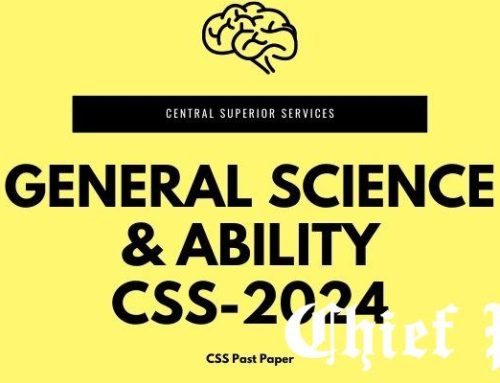
Every Day Science 2011 — CSS Past Paper
COMPETITIVE EXAMINATION FOR
RECRUITMENT TO POSTS IN BS-17
UNDER THE FEDERAL GOVERNMENT, 2011
GENERAL KNOWLEDGE, PAPER-I
(EVERYDAY SCIENCE)
Q.1. Select the best option/answer and fill in the appropriate box on the answer sheet. (1 x 50 = 50)
(1) The planet of the solar system which has maximum number of Moon is:
(a) Jupiter (b) Venus (c) Saturn (d) Uranus
(e) None of these.
(2) Sun is a:
(a) Planet (b) Comet (c) Satellite (d) Aurora
(e) None of these.
(3) The age of the solar system is:
(a) 4.5 billion years (b) 5.5 billion years
(c) 6.5 billion years (d) 7.5 billion years (e) None of these.
(4) A unit of length equal to the average distance between the Earth and Sun is called:
(a) Light year (b) Astronomical unit (c) Parsec (d) Parallax
(e) None of these.
(5) An eclipse of the Sun occurs when:
(a) The Moon is between the Sun and the Earth (b) The Sun is between the Earth and the Moon
(c) The Earth is between the Sun and the Moon (d) The Earth casts its shadow on the Moon
(e) None of these.
(6) The ozone layer protects the Earth from rays sent down by the Sun:
(a) Ultraviolet rays (b) Infrared rays (c) Gamma rays
(d) Radioactive rays (e) None of these.
(7) The ozone layer is present about 30 miles (50 Km) in atmosphere above the Earth. The stratum (layer)
of atmosphere in which ozone layer lies is called as:
(a) Exosphere (b) Mesosphere (c) Stratosphere
(d) Ionosphere (e) Troposphere
(8) Which rocks are formed by the alteration of pre-existing rocks by great heat or pressure?
(a) Igneous rocks (b) Sedimentary rocks (c) Metamorphic rocks
(d) Acid rocks (e) Basic rocks.
(9) The most abundant natural Iron Oxides are:
(a) Magnetite and Pyrite (b) Magnetite and Bauxite (c) Hematite and Pyrite
(d) Hematite and Magnetite (e) Hematite and Bauxite
(10) The two most abundant elements in sea water are:
(a) Sodium and Potassium (b) Sodium and Calcium (c) Sodium and Chlorine
(d) Chlorine and Iodine (e) Magnesium and Sulphur
(11) An electric current can produce:
(a) Chemical effect (b) Magnetic effect (c) Heating effect
(d) All of these three (e) None of these
(12) The unit of home electricity energy consumption is:
(a) Watt hour (b) Kilowatt hour (c) Joule hour
(d) Kilojoule hour (e) None of these.
(13) The magnet always points in the same direction, if allowed to move freely i.e. towards North and
South poles, because of:
(a) Gravitational field (b) A lot of metal deposits on North and South Poles
(c) Due to attraction of North Pole and repulsion of Western Pole
(d) Earth is a huge magnet (e) None of these.
(14) When sound is reflected from floor, ceiling or a wall, it mixes with the original sound and changes its
complexion, it is called as:
(a) Sound (b) Echo (c) Reverberation (d) Noise (e) None of these.
(15) The speed of sound in dry air at 20 °C is about:
(a) 130 meters per second (b) 230 meters per second (c) 330 meters per second
(d) 430 meters per second (e) None of these.
(16) The speed of light in vacuum is about:
(a) 300 Million meters per second (b) 300 Million meters per hour
(c) 300 Million kilometres per second (d) 300 Million kilometres per hour (e) None of these.
(17) The time, light takes from the Sun to reach Earth is:
(a) 8 minutes (b) 25 minutes (c) 45 minutes (d) 60 minutes (e) None of these.
(18) Light from the Sun travels a distance before it reaches the Earth :
(a) 50 million Km (b) 100 million Km (c) 150 million Km
(d) 200 million Km (e) None of these.
(19) The most suitable thermometer for measuring the boiling point of water is:
(a) Mercury thermometer (b) Alcohol thermometer (c) Bimetallic thermometer
(d) Liquid crystal thermometer (e) None of these.
(20) The density of water is greatest at:
(a) -32 °C (b) 0 °C (c) 4 °C (d) 100 °C (e) None of these.
(21) Which one of the following statements is true?
(a) Gases do not conduct heat (b) The best conductors are non-metals
(c) Conduction currents occur only in liquids (d) A vacuum can not conduct heat
(e) None of the statements is true.
(22) Ice can be changed to water by:
(a) Adding more water molecules (b) Changing the motion of the water molecules
(c) Rearranging the atoms in water molecules (d) Destroying the atoms in water molecules
(e) None of these.
(23) The building blocks of elements are called:
(a) Atoms (b) Molecules (c) Compounds (d) Isotopes (e) None of these.
(24) Boiling of an egg is a change which is:
(a) Physical (b) Chemical (c) Physiological (d) Morphological
(e) None of these.
(25) The temperature of liquid Nitrogen is:
(a) -32 °C (b) -80 °C (c) -100 °C (d) -196 °C (e) None of these.
(26) Which one of the following is an alkali?
(a) Water (b) Vinegar (c) Lemon juice (d) Slaked lime
(e) None of these.
(27) If an alkali is slowly added to an acidic solution, the pH of the acidic solution will:
(a) Increase (b) Decrease (c) Increase to 7 and then decrease
(d) Decrease to 7 and then increase (e) Will remain same.
28) The usual raw material for ceramics, generally found beneath the top soil is?
(a) Sand (b) Silt (c) Clay (d) Plaster of Paris (e) Melamine.
(29) Polyamides are synthetic polymers commonly known as:
(a) Synthetic rubber (b) Nylon (c) Cellulose (d) Protein (e) None of these.
(30) Telephone was invented in 1876 in America by:
(a) Marconi (b) Galileo (c) John Beard (d) Edison (e) Graham Bell.
(31) Information can be sent over long distances in the form of:
(a) Electrical signals through wires (b) Light signals through optical fibres
(c) Radio waves through air (d) Any combination of these three (e) None of these.
(32) Information can be stored in:
(a) Audio and video cassettes (b) Floppy and compact discs (c) Hard disks
(d) Laser and optical disks (e) All of these four.
(33) Computers can:
(a) Add and subtract information only (b) Add, subtract and sort information only
(c) Add, subtract, sort and classify information (d) Add and subtract but cannot sort information
(e) Add, subtract and sort but cannot classify information.
(34) IBM stands for:
(a) International Business Machines (b) International Big Machines
(c) Interrelated Business Machines (d) Interrelated Big Machines (e) None of these.
(35) Chemicals used to kill weeds are called as:
(a) Insecticides (b) Fungicides (c) Herbicides
(d) Fumigants (e) None of these.
(36) The cytoplasm consists of several types of structures, which are called:
(a) Protoplasm (b) Nucleus (c) Cytochromes
(d) Organelles (e) None of these.
(37) The structure of DNA was elaborated by Watson and Crick in:
(a) 1909 (b) 1923 (c) 1945 (d) 1953
(e) None of these.
(38) In a DNA molecule, the rule for base pairing is:
(a) Adenine always bound with thymine and cytosine with guanine
(b) Adenine always bound with cytosine and thymine with guanine
(c) Adenine always bound with guanine and cytosine with thymine
(d) Adenine always bound with uracil and cytosine with guanine
(e) None of these.
(39) Man belongs to the family:
(a) Felidae (b) Hominidae (c) Mammalia (d) Primataceae (e) None of these.
(40) Deficiency of vitamin C in the human body causes a deficiency disease called:
(a) Beriberi (b) Night blindness (c) Rickets (d) Scurvy (e) None of these.
(41) To measure the specific gravity of milk, the instrument used is:
(a) Hygrometer (b) Barometer (c) Lactometer (d) Hydrometer (e) None of these.
(42) One of the fundamental characteristics of living organisms is:
(a) Photosynthesis (b) Digestion (c) Excretion (d) Metabolism (e) None of these.
(43) Plants growing on other plants are called as:
(a) Saprophytes (b) Parasites (c) Epiphytes (d) Pathogens (e) None of these.
(44) As per eating habit, squirrels are:
(a) Frugivorous (b) Herbivorous (c) Carnivorous (d) Omnivorous
(e) Insectivorous.
45) Water loss from leaves through stomata is called as:
(a) Evaporation (b) Transpiration (c) Evapo-transpiration (d) Respiration
(e) None of these.
(46) The study of how plants and animals interact with one another and with the non-living environment is
called as:
(a) Ecosystem (b) Sociology (c) Ecology (d) Habitat (e) None of these.
(47) The number of bones in human body is:
(a) 200 (b) 202 (c) 204 (d) 206 (e) None of these.
(48) Nervous system in human body consists of:
(a) Brain and spinal cord (b) Brain and nerves (c) Spinal cord and nerves
(d) Brain, spinal cord and nerves (e) None of these.
(49) In human eye, the light sensitive layer made of specialized nerve cells, the rods and cones is called as:
(a) The pupil (b) The cornea (c) The sclera (d) The iris (e) The retina.
(50) Erythrocytes are also called as:
(a) Red blood cells (b) White blood cells (c) Platelets
(d) Plasma (e) None of these.
PART-II
NOTE: (i) PART-II is to be attempted on separate Answer Book.
(ii) Attempt ONLY FIVE questions from PART-II. All questions carry EQUAL marks.
(iii) Extra attempt of any question or any part of the attempted question will not be
considered.
Q.2. Write short note on the following Muslim scientists by giving their exact life span and contribution to
the field of science:- (5 x 2 = 10)
(a) Jabar-bin-Hayan (b) Bu Ali Sina
Q.3. Differentiate between any FIVE of the following pairs:- (5 x 2 = 10)
(a) Typhoons and Tornadoes (b) Microscope and Telescope (c) Ultrasonics and Infrasonics
(d) Hard water and Heavy water (e) Isotopes and Isomers (f) Antibodies and Antibiotics
(g) Antigen and Vaccine
Q.4. (a) What is a galaxy? The Earth belongs to which galaxy? (1+1 = 2)
(b) Briefly describe what is big bang theory. (4)
(c) Do you think that Pluto is still ninth planet of our solar system? If yes, how and if not
why? (1+3)
Q.5. (a) Basically how many forms of energy are there? Also name these. (1+1 = 2)
(b) Enlist different types of energy. (4)
(c) Why are scientists trying to find alternate energy sources? (2)
(d) What is a renewable energy source? Quote three examples of renewable energy sources. (2)
Q.6. Is plastic a natural or an artificial polymer? Describe various types of plastics and their uses. (10)
Q.7. (a) What do the following abbreviations stand for:
(i) LAN (ii) HTTP (iii) HTML (iv) PDF (v) URL (1 x 5 = 5)
(b) Differentiate between natural and artificial satellites. For what purpose artificial satellites are
used? (5)
Q.8. (a) What is the main function of: (1 x 5 = 5)
(i) Ribosome (ii) Mitochondria (iii) Lysosomes (iv) Chloroplasts
(v) Golgi apparatus
(b) Give habitats of following animals: (1 x 5 = 5)
(i) Rattle snake (ii) Ostrich (iii) Platypus (iv) Rhinoceros
(v) Chimpanzee.
Q.9. Write short notes on the following:- (2 x 5 = 10)
(a) Nucleic acids (b) Fertilizers (c) Semiconductors (d) Microwave oven (e) Internet










